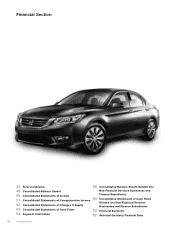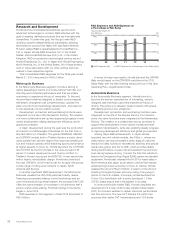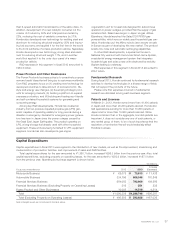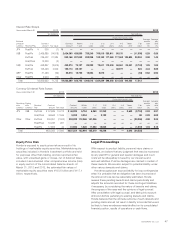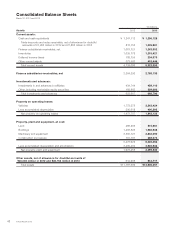Honda 2013 Annual Report Download - page 40
Download and view the complete annual report
Please find page 40 of the 2013 Honda annual report below. You can navigate through the pages in the report by either clicking on the pages listed below, or by using the keyword search tool below to find specific information within the annual report.
In Motorcycle business, we made capital expenditures of
¥73,513 million in the fiscal year ended March 31, 2013. Funds
were allocated to the introduction of new models, as well as
the improvement, streamlining and modernization of produc-
tion facilities, and improvement of sales and R&D facilities.
In Automobile business, we made capital expenditures of
¥505,045 million in the fiscal year ended March 31, 2013.
Funds were allocated to the introduction of new models, as well
as the improvement, streamlining and modernization of produc-
tion facilities, and improvement of sales and R&D facilities.
In Financial services business, capital expenditures
excluding property on operating leases amounted to ¥551
million in the fiscal year ended March 31, 2013, while capital
expenditures for property on operating leases were ¥793,118
million. Capital expenditures in Power products and other
businesses in the fiscal year ended March 31, 2013, totaling
¥14,519 million, were deployed to upgrade, streamline, and
modernize manufacturing facilities for power products, and to
improve R&D facilities for power products.
Plans after Fiscal 2013
During the fiscal year ended March 31, 2013, we modified
our capital expenditure plans which were originally set out in
the prior fiscal year. The modified plans are as follows:
The second auto plant in Rajasthan, India, constructed by
Honda Cars India Limited, which is one of the Company’s con-
solidated subsidiaries, is planned to start operations from 2014.
Managements mainly consider economic trends of each
region, demand trends, situation of competitors and our
business strategy such as introduction plans of new models
in determining the future of projects.
The estimated amounts of capital expenditures for fiscal
year ending March 31, 2014 are shown below.
Yen (millions)
Fiscal year ending March 31, 2014 2014
Motorcycle Business ¥ 64,000
Automobile Business 623,000
Financial Services Business 700
Power Product and Other Businesses 12,300
Total ¥700,000
Note: The estimated amount of capital expenditures for Financial services business
in the above table does not include property on operating leases.
Intangible assets are not included in the table above.
Liquidity and Capital Resources
Overview of Capital Requirements,
Sources and Uses
The policy of Honda is to support its business activities by
maintaining sufficient capital resources, a sufficient level of
liquidity and a sound balance sheet.
Honda’s main business is the manufacturing and sale of
motorcycles, automobiles and power products. To support
this business, it also provides retail financing and automobile
leasing services for customers, as well as wholesale financing
services for dealers.
Honda requires working capital mainly to purchase parts
and raw materials required for production, as well as to
maintain inventory of finished products and cover receiv-
ables from dealers and for providing financial services.
Honda also requires funds for capital expenditures, mainly
to introduce new models, upgrade, rationalize and renew
production facilities, as well as to expand and reinforce
sales and R&D facilities.
Honda meets its working capital requirements primarily
through cash generated by operations, bank loans and the
issuance of commercial paper. Honda believes that its work-
ing capital is sufficient for the Company’s present require-
ments. The year-end balance of liabilities associated with the
Company and its subsidiaries’ funding for non-Financial ser-
vices businesses was ¥540.2 billion as of March 31, 2013. In
addition, the Company’s finance subsidiaries fund financial
programs for customers and dealers primarily from medium-
term notes, bank loans, securitization of finance receivables,
commercial paper, corporate bonds, and intercompany loans.
The year-end balance of liabilities associated with these
finance subsidiaries’ funding for Financial services business
was ¥4,863.5 billion as of March 31, 2013.
Cash Flows
Consolidated cash and cash equivalents on March 31, 2013
decreased by ¥40.9 billion from March 31, 2012, to ¥1,206.1
billion. The reasons for the increases or decreases for each
cash flow activity, when compared with the previous fiscal
year, are as follows:
Net cash provided by operating activities amounted to
¥800.7 billion of cash inflows. Cash inflows from operating
activities increased by ¥39.2 billion compared with the previ-
ous fiscal year due mainly to an increase in cash received due
to increased unit sales in Automobile business, which was
partially offset by increased payments for parts and raw mate-
rials primarily caused by an increase in automobile production.
Net cash used in investing activities amounted to ¥1,069.7
billion of cash outflows. Cash outflows from investing activi-
ties increased by ¥396.6 billion compared with the previous
fiscal year, due mainly to an increase in capital expenditure,
acquisitions of finance subsidiaries-receivables and purchase
of operating lease assets.
Capital Expenditures and Depreciation
Years ended March 31
Yen (billions)
Capital Expenditures Depreciation
Note: Capital Expenditure and Depreciation aforementioned exclude Capital
Expenditure and Depreciation in operating lease assets and intangible assets.
250
500
750
009 10 11 12 13
Annual Report 201338






